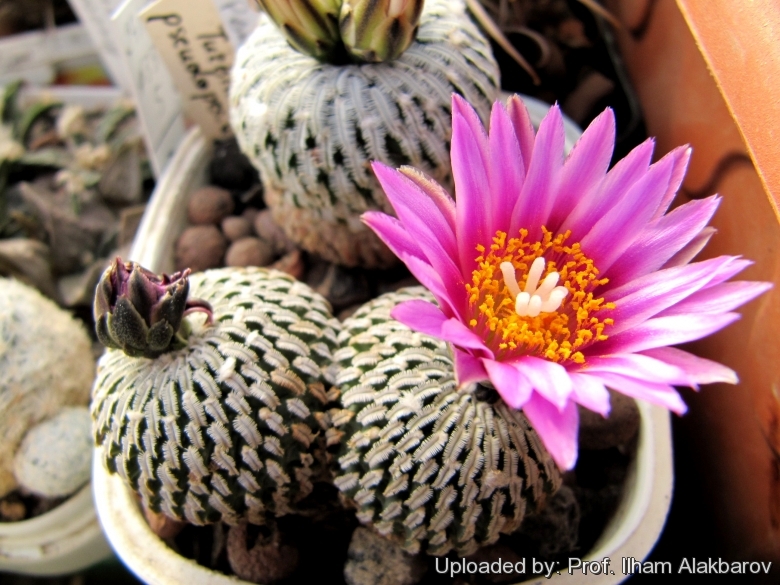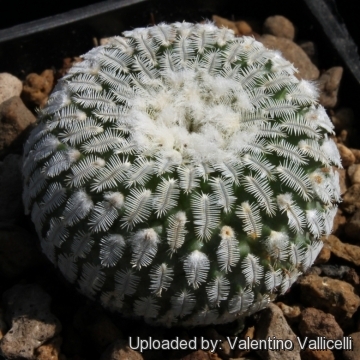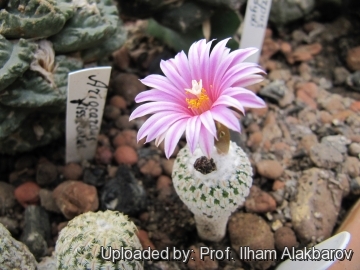Accepted Scientific Name: Turbinicarpus pseudopectinatus (Backeb.) Glass & R.A.Foster
Cact. Succ. J. (Los Angeles) 49: 175. 1977

Turbinicarpus pseudopectinatus f. rubriflorus Photo by: Prof. Ilham Alakbarov
Origin and Habitat: Nuevo Leon and Guanajuato, Mexico (Northern America).
Type locality: Stony hills near Xichu, Guanajuato.
Habitat: Slightly steep terrain amomg dense bushes.
Synonyms:
See all synonyms of Turbinicarpus pseudopectinatus
back
Accepted name in llifle Database:Turbinicarpus pseudopectinatus (Backeb.) Glass & R.A.FosterCact. Succ. J. (Los Angeles) 49: 175. 1977Synonymy: 16
back
Description: Turbinicarpus pseudopectinatusSN|1523]]SN|1523]] is a solitary small geophytic cactus with many small spirally-arranged tubercles tipped with numerous tiny white spines in a comb like formation.
Forma rubriflorus (red flowering form) This peculiar form differs from the standard species for its bright magenta-red blooms. Except for the flowers it is identical in shape and size to the standard species.
Habit: It is a small geophytic solitary cactus with a large tap-root, and only the apical part of the stem exposed at soil level.
Stem: Globular dull green, 3 cm tall, 4 cm in diameter, barely showing above the ground. Apex with short white hair.
Tubercles: Spirally-arranged.
Spines: Numerous white in a comb like formation (pectinated), 1,2 mm long.
Root: Tuberose and usually bigger than the stem itself.
Flowers: One to 5 bright pink to bright magenta with darker magenta or reddish-brown mid-veins.
Blooming season: Blossoms are expected early in spring. Flowers can be expected on Turbinicarpus pseudopectinatusSN|1523]]SN|1523]] seedlings after perhaps two or three years if they are grown well in plant that are only 1,5 cm in diameter, while the flower is 4 cm long.
Fruit: Small tannish-green.
Subspecies, varieties, forms and cultivars of plants belonging to the Turbinicarpus pseudopectinatus group
Bibliography: Major references and further lectures
1) Edward Anderson “The Cactus family” Timber Press, Incorporated, 2001
2) Nathaniel Lord Britton, Joseph Nelson Rose “Cactaceae: Descriptions and Illustrations of Plants of the Cactus Family” vol. 4 The Carnegie Institution of Washington, Washington 1923
3) James Cullen, Sabina G. Knees, H. Suzanne Cubey "The European Garden Flora Flowering Plants: A Manual for the Identification of Plants Cultivated in Europe, Both Out-of-Doors and Under Glass" Cambridge University Press, 11/Aug/2011
4) David R Hunt; Nigel P Taylor; Graham Charles; International Cactaceae Systematics Group. "The New Cactus Lexicon" dh books, 2006
5) Milan Zachar, Roman Staník, Alexander Lux, Igor Dráb "Rod Turbinicarpus (Gattung Turbinicarpus)" Vydavateľstvo Roman Staník, 1996
6) Davide Donati, Carlo Zanovello "Knowing Understanding and Growing Turbinicarpus-Rapicactus. A trip across the mexican states of Coahuila, Guanajuato, Hidalgo, Nuevo Leon, Queretaro..." Cactus Trentino Südtirol, 2005
 - MMR144 La Escondida, Nuevo León, Mexico Photo by: Valentino Vallicelli
- MMR144 La Escondida, Nuevo León, Mexico Photo by: Valentino Vallicelli Turbinicarpus pseudopectinatus f. rubriflorus Photo by: Prof. Ilham Alakbarov
Turbinicarpus pseudopectinatus f. rubriflorus Photo by: Prof. Ilham AlakbarovCultivation and Propagation: It’s a fairly easy and robust species to cultivate, but very slow growing. It needs a very well-drained soil, and requires strong sun to part sun to keep the plant compact and low and to develop a good spinal growth. Waterings should be rather infrequent to keep the plant compact, and avoid its becoming excessively elongated and unnatural in appearance. Furthermore it has a tap root, and watering it properly is often difficult, because it tends to crack open or rot if over-watered. Careful watering away from the body of the plant will allow the areoles to keep their wool. Keep dry in winter, or when night temperatures remain below 10° C. It is hardy to -4°C for a short period. Assure a good ventilation.
Reproduction: From seed, since the plant rarely produces plantlets, or grafted.













